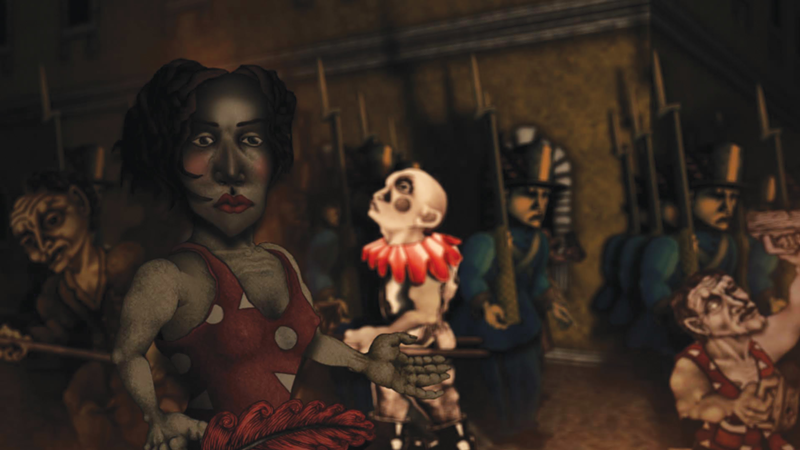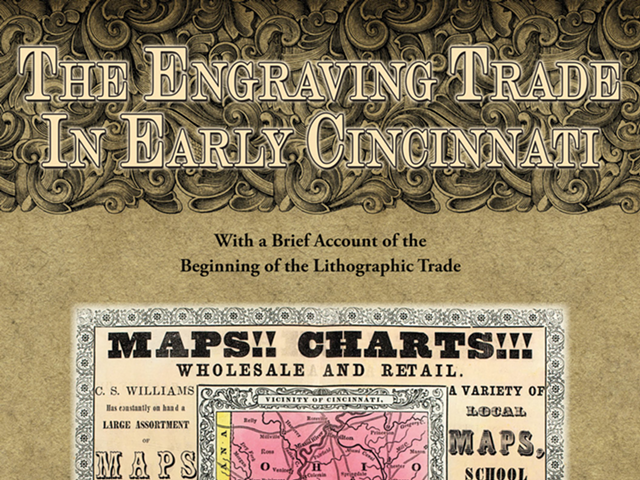The complexity, mysterious beauty, level of accomplishment and downright strangeness of Jay Bolotin’s art is continually amazing.
Because of the elaborateness of his work as well as the thought-through vision (it feels like he’s exploring a foreign land that somehow avoided modernism), it can seem that each piece, each show, is part of some slowly unfolding, hypnotically transfixing magnum opus. No wonder it can take him years between shows.
Kharmen, a new 22-minute film made by digitally animating his graphite drawings, is currently being shown — along with some of the original drawings for it — at Downtown’s Weston Gallery. This is different, but related in style, to his previous film Jackleg Testament: Part One, for which he animated woodcuts.
Kharmen is part of the Seeing Opera group exhibition curated by Stewart Goldman, a longtime Cincinnati artist like Bolotin. (Goldman also is professor emeritus at Art Academy of Cincinnati.) The show, up through Aug. 31, was originally envisioned to accompany what was to be Cincinnati Opera’s current season at Aronoff Center for the Arts (where the Weston Gallery is located) while Music Hall was undergoing renovation. That work has been delayed and the Opera has stayed put, but this show has gone on.
Seven of the eight other Seeing Opera artists try to use their visual art to conjure associations with this year’s operas — Don Giovanni, Galileo Galilei, Aida and Der Rosenkavalier. Bolotin, however, goes his own way to create something new and forceful in its own right. (He previously composed Limbus: A Mechanical Opera.)
His Kharmen is somewhat based on Bizet’s 1875 Carmen (which Cincinnati Opera will present next year), about a wild-spirited factory worker in Seville. It’s an ever-popular opera, but Bolotin’s vision of it is both postmodern and steampunk.
One of his characters, the anguished and anxious Mr. Sousaphone Man, “a former vaudeville actor turned wilderness guide,” is traveling through the predominantly gray palette of his landscape. Others fight to exist somewhere between abject flatness and full dimensionality, but he just wants to get home and play his beloved aria from Carmen.
Things aren’t completely gray — there is some color, including a vividly red rose and feathers that float about like elusive dreams.
When he finally gets a chance to play his music, he doesn’t find release as much as … dread? A light explodes, fire erupts outside a window and, well, trying to describe exactly what is happening is bit like trying to catch an abstraction with a net. Suffice to say, unlike The Drowsy Chaperone, which has a similar framing device, this isn’t a musical comedy.
Music from Carmen is featured on the film’s soundtrack, although not in any conventional way. Bolotin found an old 78-rpm recording of Carmen, made by the RCA Victor Orchestra, and has sampled it being played on a Victrola and Wax Cylinder Machine. For the aria, he recorded mezzo-soprano Suzanne Lommler singing at Simpson College in Indianola, Iowa.
The film’s music — so alluring and haunting — also features Tatiana Berman on violin, improvising a solo and ensemble parts based on a theme by Bolotin. And there are Russian Orthodox and Hebrew chants by bass baritone Monte Jaffe.
There’s an overall sensibility to Kharmen of a very dark, surreal take on Sholem Aleichem’s Eastern Europe, though Bolotin gives source and title credit to absurdist Russian writer Daniil Kharms. (He also lists his own project, The Book of Only Enoch, as a source and gives the late local writer Aralee Strange credit for “additional story supervision.”) There’s probably meaning to all this. But before one gets to pondering it, you have to spend time considering Bolotin’s artistic vocabulary. It is time well spent.
Seeing Opera’s other participating artists are Goldman, Deborah Brod, Denise Burge, Peter Haberkorn, Jill Rowinski, Rebecca Seeman, Joey Versoza and Howard Wells. Versoza’s 32-minute color video Goose Opera: A Mall Tragedy bears singling out. By listening to Mozart’s Don Giovanni, he somehow was inspired to record Canadian geese sitting around the entrance of Florence Mall, where he worked.
Supposedly the geese are involved in a mating ritual by being there. There is a Warhol-esque deadpan to the long takes of the slow-moving geese near the entrances of the architecturally dreary mall. But you also start to think deeply about the relationship of nature to the ever-encroaching suburban built environment.
For more information on the show, visit westonartgallery.com.
CONTACT STEVEN ROSEN: [email protected]






